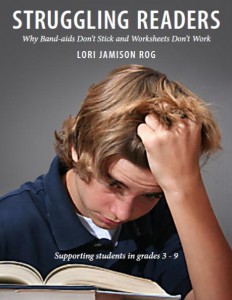WANT BETTER ANSWERS? ASK BETTER QUESTIONS!
In their meta-analysis of the research on “Writing to Read,” Steve Graham and Michael Hebert listed the lowly comprehension question as one of the writing activities that has positive effect on reading comprehension – as long as those questions are well-crafted and the students are taught what an effective response looks like.
Here are SIX TIPS for crafting better comprehension questions from Struggling Readers: Why Worksheets Don’t Work and Band-aids Don’t Stick by Lori Jamison Rog:
Make sure the question or prompt actually requires readers to understand and think about the text. You’d be surprised how often students can answer questions like, “What would you do if…” without even reading the text, much less understanding it! Effective comprehension questions should require students to think about – and beyond – the text.
Craft questions so that they actually assess reading skills and strategies. A question that asks, “What does the word chaos mean?” asks about a students’ vocabulary knowledge (and may have nothing to do how well he or she has read the passage) while rephrasing the question as “What clues in the text help you understand the word chaos?” actually assesses the reader’s ability to solve a word in context.
Be explicit; clearly ask students to explain why or give evidence from the text. If you ask a most youngsters a question that can be answered in one word, they will answer in one word. This is particularly true for struggling readers, many of whom tend to take everything they read literally. Always ask, “How do you know?” or “Why do you think so?”
Make sure that the reading level of the question or prompt is not above the reading level of the text. From our knowledge of readability, we know that long sentences are one of the factors that make text difficult. Chop up long sentences into shorter ones for struggling readers. If there are multiple parts to a question, create a sentence for each; better yet, bullet each point, so that struggling readers see clearly that they are required to answer more than one part.
Explicitly teach students what effective responses look like. This is particularly important for struggling readers. Share with students a rubric for assessing written responses and use a shared writing routine to collaboratively write responses. Here’s a ready-to-use mini lesson for teaching students how to apply the criteria for effective responses.
Don’t rule out multiple choice questions. Choosing from among a set of well-crafted responses (known as “distractors”) can actually generate more critical thinking than an extended response. Take the guesswork out of multiple-choice by requiring students to explain their selections. (This is also excellent practice for large-scale assessments.)


